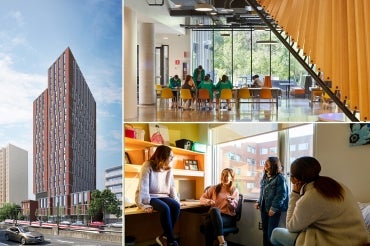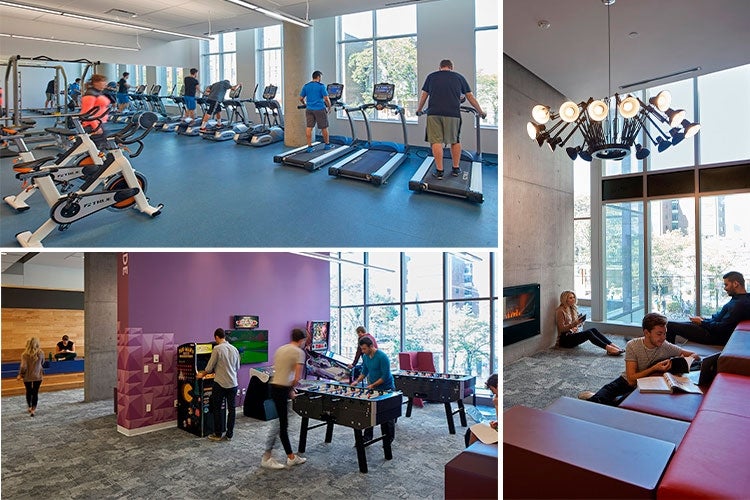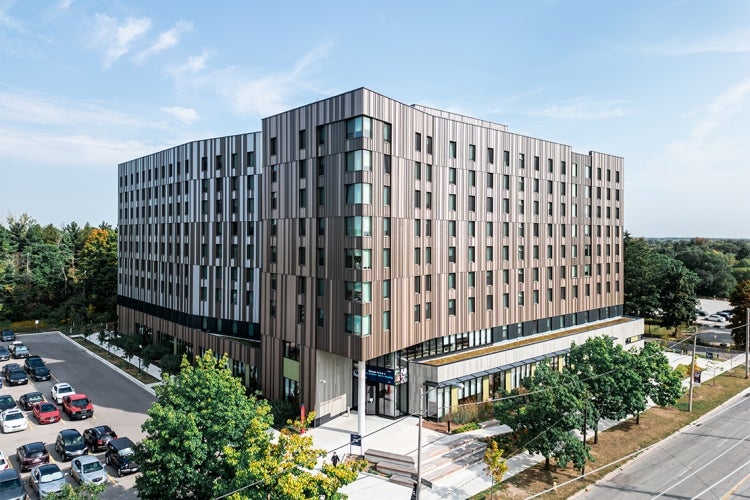On-campus housing: U of T to create thousands of new residence spaces within next decade

(Oak House rendering by Cheryl Wen/Bezier, Harmony Commons by Tom Arban and U of T Mississauga residence by Stephen Dagg)
Published: May 14, 2025
Scott Mabury knows the many benefits of living in residence. During his undergraduate studies, he lived on campus at a small, sustainability-oriented college, helping to shape his academic career in environmental chemistry.

Now the University of Toronto’s vice-president of operations and real estate partnerships, Mabury is working hard to make sure more U of T students have the opportunity to enjoy a similar experience – one that’s been shown to boost academic performance, social connections and overall enjoyment.
With surveys showing more students than ever are seeking safe and accessible living options, U of T is planning and building several new residences across its three campuses – including Oak House, scheduled to open on the St. George campus this year.
Mabury recently spoke to U of T News about the benefits of residence living and how U of T is working to meet growing demand.
How does U of T’s first-year residence guarantee inform the university’s overall housing strategy?
We know from the evidence that students who live in campus housing – in first year or beyond – tend to enjoy their experience more, graduate sooner, and perform better academically. We’ve followed that evidence, and today, the majority of incoming students live on campus.

Last year, we acquired a stake in Campus One, adding 890 student spaces. At U of T Scarborough, we opened Harmony Commons, adding 746 more. These residences contribute to the housing mix around the university and take pressure off the local housing market.
We are seeing demand growing far beyond first-year students, however. Students perceive our housing to be better value – both financially and in terms of the academic and social benefits. More upper year undergraduate, as well as graduate students, want to live in residence than we can accommodate, for example.
Our student population has also changed. We were once more of a commuter school, but now over 40 per cent of our students come from outside Ontario – across Canada and internationally. Still, only about 10 per cent live on campus, which is low compared to other universities. We’re planning for that number to grow.

What sets U of T residences apart from private-sector housing?
Oak House, which is opening this year with 508 bedrooms, is a good example of what U of T housing offers. In addition to a variety of housing styles and on-site food services, it features music rooms, project and design rooms, fitness and wellness studios and programming and community activities.
It’s also a mixed-housing model: undergraduate and graduate students live alongside 10 townhouses for faculty. That mix reflects our broader strategy. The GTA has immense talent in areas like life sciences, artificial intelligence and public policy. For faculty joining U of T, living near campus is ideal – but downtown housing costs often push people further out. By offering faculty housing, we align with other top universities globally and strengthen our ability to recruit top talent. And of course, for students, the benefits of informal chats with a faculty member at breakfast or lunch is invaluable.

How does Ontario’s Bill 185, which aims to speed the housing development process, affect U of T’s plans?
Oak House is a good example of the type of housing the bill supports at scale. It is a joint venture with a very high-quality housing developer in the Daniels Corporation. But getting it built was a decade-long process – we could have had students living there years ago.
Bill 185 encourages this type of joint venture and gives us the ability to build what is needed and what is appropriate and to do so faster by streamlining approvals.
Private-sector partners bring skills and resources we don’t have. We bring students and a deep understanding of the programs and amenities they want. Together, we can do more than either could do alone.
What will U of T’s student housing experience look like 10 years from now?
We will have many more spaces, as many as 5,000 new residence spaces across or near our three campuses and substantially more housing for our faculty and staff.
The university will have residences that deliver a great experience to students and demonstrate how to build energy-efficient housing at scale – and do it in a financially responsible way. For example, Harmony Commons, 746 beds at the University of Toronto Scarborough, received Passive House certification, the largest building in Canada to do so. Oak House incorporates geo-exchange heating and cooling systems.
We are building the most energy efficient-housing in Toronto, so our residences will also be contributing to U of T’s goal of making all three campuses climate positive by 2050.



